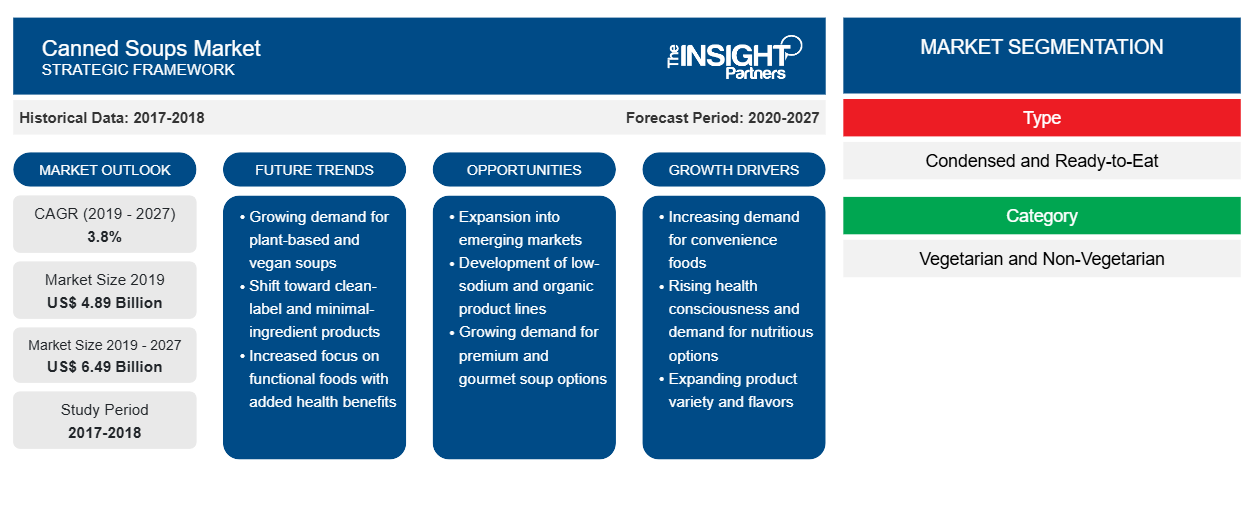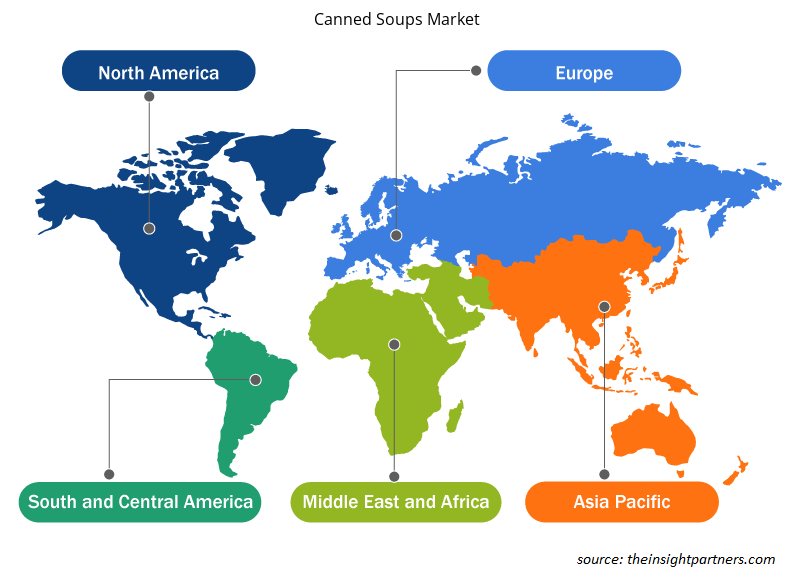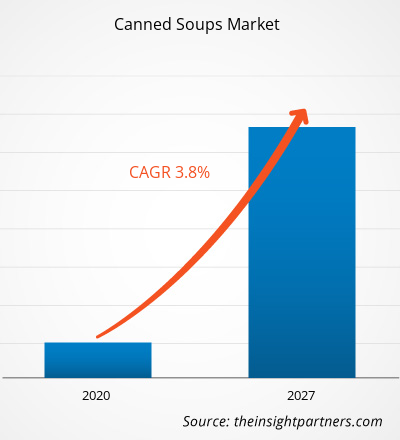The canned soups market was valued US$ 4,889.04 million in 2019, it is estimated to grow at a CAGR of 3.8% from 2020 to 2027.
High demand for ready-to-eat food products, rapid shift in consumer food preferences, and increase in health concerns are driving the growth of the canned soup market. Canned soups is a ready-to-eat convenient food product that is easily available in the market. Processing the canned soups is easy and takes less time for the preparation. Canned soup export business has also augmented in recent times owing to the high acceptance power for these products among consumers and brand awareness among the developing economies. Furthermore, the growing working population and increasing preferences for processed food products due to their health benefits boost demand for canned soup products. In addition, shifting of rural population to urban areas in developing countries in Asia Pacific—such as China and India is also projected to increase the demand for various consumer goods, which is also expected to boost the growth of the canned soups market during the forecast period.
In 2019, North America contributed to the largest share in the global canned soups market. Increasing instance of obesity and rising campaigns regarding health awareness in the North America propelled the demand for packaged soup having natural and fresh ingredients. Therefore, the demand for canned soup has also increased and manufacturers are providing different flavors to the consumers. The increase in the variety of products, surge in the consumption of healthy products, and promotion by the key players in the region have increased the demand for canned soup in North America.
The COVID-19 outbreak was first reported in Wuhan (China) during December 2019. As of January 2021, the US, Brazil, India, Russia, Spain, and the UK are among the worst affected countries in terms of confirmed cases and reported deaths. The pandemic is adversely affecting economies and industries in various countries due to lockdowns, travel bans, and business shutdowns. The food & beverage is one of the world’s major industries suffering serious disruptions such as supply chain breaks, technology events cancellations, and office shutdowns. For instance, China is the global manufacturing hub and largest raw material supplier for various industries and it is also one of the worst affected countries. The lockdown of various plants and factories in China is disrupting the global supply chains and hindering the manufacturing activities, delivery schedules, and various materials sales. Various companies have already announced possible delays in product deliveries and slump in future sales of their products. In addition, the global travel bans imposed by countries in Europe, Asia, and North America are hampering the business collaborations and partnerships opportunities. All these factors are hindering the industries, and thus act as restraining factor for the growth of various markets related to this industry.
Customize This Report To Suit Your Requirement
You will get customization on any report - free of charge - including parts of this report, or country-level analysis, Excel Data pack, as well as avail great offers and discounts for start-ups & universities
Canned Soups Market: Strategic Insights

- Get Top Key Market Trends of this report.This FREE sample will include data analysis, ranging from market trends to estimates and forecasts.
You will get customization on any report - free of charge - including parts of this report, or country-level analysis, Excel Data pack, as well as avail great offers and discounts for start-ups & universities
Canned Soups Market: Strategic Insights

- Get Top Key Market Trends of this report.This FREE sample will include data analysis, ranging from market trends to estimates and forecasts.
Market Insights
High Shelf Life of Canned Food Products
The shelf life of any canned soup is the amount of time it requires to degrade to the non-palatable state. Shelf life extension ingredients added in the canned soup products slow down the process of food degradation and enable longer storage of the food items. They are both organic and conventional in origin. Shelf life extension ingredients also aid in the keeping food logistics decongested, sustain canned soups in frozen areas, and improve consumer confidence over stability of food items. Consumers have become more aware about their diet. Health benefits such as improved immunity, lower caloric intake, and high protein intake are other factors expected to influence the product demand. Moreover, canned soups with high shelf life also comprise high content of nutrition, minerals, vitamins, and proteins. On a global level, youngsters are preferring to purchase premium goods due to health attributes and are ready to change their habits toward healthier nutrition. Canned soup made from fresh vegetables, and bone and meat has gained tremendous popularity as it offers various health benefits and nutrition as well as it has a high shelf life. In addition, consumers are opting for canned soup products over other protein sources owing to its benefits such as the presence of macro and micronutrient in good proportion with a high concentration of protein. Additionally, packed soups are majorly preferred over soups served in the restaurants and food outlets due to ease of access as well as durability of packages. Drinking canned soups or making a simple soup help add more protein into the diet and prevents one from consuming too many calories. Thus, consumer’s inclination toward nutrition-based canned soup drives the market growth.
Type Insights
Based on type, the global canned soups market is bifurcated into condensed and ready-to-eat. In 2091, the condensed segment led the market. Condensed canned soup products are produced by using a wide variety of seasonings and foods that offer high nutritional value. The consumption of condensed soup offers numerous health benefits as well as it is a concentrated source of protein and calcium, which play a vital role for the building of body. Thus, the market for condensed soup segment is expected to growth significantly during the forecast period.
Distribution Channel Insights
The canned soups market, by distribution channel, is segmented into hypermarkets/supermarkets, convenience stores, online, and others. In 2019, the hypermarkets/supermarkets segment dominated the market, whereas the market for the online segment is anticipated to grow at the swiftest growth rate during 2020–2027. Hypermarket and supermarket are considered a minor sales channel for the sales of canned soups and the vast array of other products. Canned soups are also placed at an eye-catching assortment on shelves of hypermarkets and supermarkets to attract customers. These stores offer products of different brands in one place with affordable prices than other distribution channels. Also, products of different brands are placed nearby to help buyer select suitable products in less time. Apart from this, factors such as hassle-free transactions, bulk purchasing, better services, and a pleasant customer experience encourage buyers to shop from hypermarkets and supermarkets.
A few key players operating in the canned soup market are Campbell soup company, Amy’s Kitchen Inc, General Mills Inc., The Kraft Heinz Company, Baxters Food Group, Unilever, Struik Foods Europe NV, Vanee Foods Company, BCI Foods Inc., and Hain Celestial Companies. These companies provide a wide range of product portfolio for canned soups market. They also have their presence in the developing regions, which provides lucrative opportunities for the growth of the canned soup market.
Canned Soups Market Regional Insights
The regional trends and factors influencing the Canned Soups Market throughout the forecast period have been thoroughly explained by the analysts at Insight Partners. This section also discusses Canned Soups Market segments and geography across North America, Europe, Asia Pacific, Middle East and Africa, and South and Central America.

- Get the Regional Specific Data for Canned Soups Market
Canned Soups Market Report Scope
| Report Attribute | Details |
|---|---|
| Market size in 2019 | US$ 4.89 Billion |
| Market Size by 2027 | US$ 6.49 Billion |
| Global CAGR (2019 - 2027) | 3.8% |
| Historical Data | 2017-2018 |
| Forecast period | 2020-2027 |
| Segments Covered |
By Type
|
| Regions and Countries Covered | North America
|
| Market leaders and key company profiles |
Canned Soups Market Players Density: Understanding Its Impact on Business Dynamics
The Canned Soups Market is growing rapidly, driven by increasing end-user demand due to factors such as evolving consumer preferences, technological advancements, and greater awareness of the product's benefits. As demand rises, businesses are expanding their offerings, innovating to meet consumer needs, and capitalizing on emerging trends, which further fuels market growth.
Market players density refers to the distribution of firms or companies operating within a particular market or industry. It indicates how many competitors (market players) are present in a given market space relative to its size or total market value.
Major Companies operating in the Canned Soups Market are:
- Campbell Soup Company
- Amy
Disclaimer: The companies listed above are not ranked in any particular order.

- Get the Canned Soups Market top key players overview
Report Spotlights
- Progressive industry trends in the global canned soups market to help players develop effective long-term strategies
- Business growth strategies adopted by developed and developing markets
- Quantitative analysis of the market from 2017 to 2027
- Estimation of the demand for canned soups across various industries
- PEST analysis to illustrate the efficacy of buyers and suppliers operating in the industry to predict market growth
- Recent developments to understand the competitive market scenario and the demand for canned soups
- Market trends and outlook coupled with factors driving and restraining the growth of the canned soups market
- Decision-making process by understanding strategies that underpin commercial interest with regard to the growth of the global canned soups market
- Canned soups market size at various nodes of market
- Detailed overview and segmentation of the global canned soups market as well as its dynamics in the industry
- Canned soups market size in various regions with promising growth opportunities
Canned Soups Market, by Type
- Condensed
- Ready-to-Eat
Canned Soups Market, by Category
- Vegetarian
- Non-Vegetarian
Canned Soups Market, by Processing
- Regular Soup
- Organic Soup
Canned Soups Market, by Distribution Channel
- Hypermarkets/Supermarkets
- Convenience Stores
- Online
- Others
Company Profiles
- Campbell Soup Company
- Amy’s Kitchen Inc
- General Mills Inc.
- The Kraft Heinz Company
- Baxters Food Group
- Unilever
- Struik Foods Europe NV
- Vanee Foods Company
- BCI Foods Inc.
- Hain Celestial
Frequently Asked Questions
Based on type, why condensed segment accounted for the largest share in the global canned soups market?
The condensed segment had a significant market share, and this trend is expected to continue over the forecast period. Condensed soup is a type of canned soup prepared with a low proportion of water, in which consumers can add milk or water during consumption. The global market for canned soups is projected to expand at a robust rate as canned soups products become popular worldwide. Canned soups made from fresh vegetables have gained tremendous popularity due to this soup's health benefits and nutritional value. Furthermore, the development of new preparation styles for canned soups has also aided the growth of the global canned soups market.
Can you list some of the major players operating in the global canned soups market?
The major players operating in the global canned soups market are Amy’s Kitchen Inc, Baxters Food Group, Campbell soup Company, The Kraft Heinz Company, General Mills Inc., Unilever, Hain Celestial, Struik Foods Europe NV, Vanee Foods Company, and BCI Foods Inc., among others.
Which region held the largest share of the global canned soups market?
In 2019, North America contributed to the largest share in the global canned soups market. There has been an increasing instance of obesity as well as health awareness campaigns in the North American countries which has increased the demand for packaged soup having natural and fresh ingredients. Due to the growing demand for packaged soup, the demand for canned soup has also increased, and manufacturers are providing different flavors to the consumers. The increase in the variety of products, increase in the consumption of health-related products, and promotion by the key players in the region has increased the demand for canned soup in North America.
- Historical Analysis (2 Years), Base Year, Forecast (7 Years) with CAGR
- PEST and SWOT Analysis
- Market Size Value / Volume - Global, Regional, Country
- Industry and Competitive Landscape
- Excel Dataset
Testimonials
I wish to appreciate your support and the professionalism you displayed in the course of attending to my request for information regarding to infectious disease IVD market in Nigeria. I appreciate your patience, your guidance, and the fact that you were willing to offer a discount, which eventually made it possible for us to close a deal. I look forward to engaging The Insight Partners in the future, all thanks to the impression you have created in me as a result of this first encounter.
DR CHIJIOKE ONYIA, MANAGING DIRECTOR, PineCrest Healthcare Ltd.The Insight Partners delivered insightful, well-structured market research with strong domain expertise. Their team was professional and responsive throughout. The user-friendly website made accessing industry reports seamless. We highly recommend them for reliable, high-quality research services
Yukihiko Adachi CEO, Deep Blue, LLC.Reason to Buy
- Informed Decision-Making
- Understanding Market Dynamics
- Competitive Analysis
- Customer Insights
- Market Forecasts
- Risk Mitigation
- Strategic Planning
- Investment Justification
- Identifying Emerging Markets
- Enhancing Marketing Strategies
- Boosting Operational Efficiency
- Tracking Industry Innovations
- Aligning with Regulatory Trends
Yes! We provide a free sample of the report, which includes Report Scope (Table of Contents), report structure, and selected insights to help you assess the value of the full report. Please click on the "Download Sample" button or contact us to receive your copy.
Absolutely — analyst assistance is part of the package. You can connect with our analyst post-purchase to clarify report insights, methodology or discuss how the findings apply to your business needs.
Once your order is successfully placed, you will receive a confirmation email along with your invoice.
• For published reports: You’ll receive access to the report within 4–6 working hours via a secured email sent to your email.
• For upcoming reports: Your order will be recorded as a pre-booking. Our team will share the estimated release date and keep you informed of any updates. As soon as the report is published, it will be delivered to your registered email.
We offer customization options to align the report with your specific objectives. Whether you need deeper insights into a particular region, industry segment, competitor analysis, or data cut, our research team can tailor the report accordingly. Please share your requirements with us, and we’ll be happy to provide a customized proposal or scope.
The report is available in either PDF format or as an Excel dataset, depending on the license you choose.
The PDF version provides the full analysis and visuals in a ready-to-read format. The Excel dataset includes all underlying data tables for easy manipulation and further analysis.
Please review the license options at checkout or contact us to confirm which formats are included with your purchase.
Our payment process is fully secure and PCI-DSS compliant.
We use trusted and encrypted payment gateways to ensure that all transactions are protected with industry-standard SSL encryption. Your payment details are never stored on our servers and are handled securely by certified third-party processors.
You can make your purchase with confidence, knowing your personal and financial information is safe with us.
Yes, we do offer special pricing for bulk purchases.
If you're interested in purchasing multiple reports, we’re happy to provide a customized bundle offer or volume-based discount tailored to your needs. Please contact our sales team with the list of reports you’re considering, and we’ll share a personalized quote.
Yes, absolutely.
Our team is available to help you make an informed decision. Whether you have questions about the report’s scope, methodology, customization options, or which license suits you best, we’re here to assist. Please reach out to us at sales@theinsightpartners.com, and one of our representatives will get in touch promptly.
Yes, a billing invoice will be automatically generated and sent to your registered email upon successful completion of your purchase.
If you need the invoice in a specific format or require additional details (such as company name, GST, or VAT information), feel free to contact us, and we’ll be happy to assist.
Yes, certainly.
If you encounter any difficulties accessing or receiving your report, our support team is ready to assist you. Simply reach out to us via email or live chat with your order information, and we’ll ensure the issue is resolved quickly so you can access your report without interruption.















The List of Companies - Canned Soups Market
- Campbell Soup Company
- Amy’s Kitchen Inc
- General Mills Inc.
- The Kraft Heinz Company
- Baxters Food Group
- Unilever
- Struik Foods Europe NV
- Vanee Foods Company
- BCI Foods Inc.
- Hain Celestial






 Get Free Sample For
Get Free Sample For